| Pages:
1
..
14
15
16
17
18 |
Thraxx
Hazard to Self
 
Posts: 71
Registered: 15-10-2016
Member Is Offline
Mood: No Mood
|
|
About the IP extract + IP nitrit method.
Schema of reaction:
HS Extract (3 times) + NaOH + IP nitrite == NaN3 + Na2SO4+IPA
1/8 mol=16g + 5g + 13ml == 7,5g
Extracted was 5 h at RT ,reaction was 24 h at -5C in freezer.Precipitated was with 3 vol. of ethanol(tech.)+aceton 1:1
Pictures: 1,2,3= extraction chemicals and extraction beaker
4=extract + NaOH solution in 40 ml IPalc.
5= extract with NaOH sol + IPnitrite=reaction mixture
6= the reaction mixture after 12 h.
7= reaction mixture after 24h.
8,9,10,11=filtration and amorph product
12=giving the product in the beaker before diluting
13 =product diluted in watter,very solubile
14=precipitation with alc./aceton mix
15=precipitation after 12 h. in freezer at -5C=ZERO
Conclusion: This reaction I did 13 x.Only one of these was with yield,all other reactions produced either dark liquid or ,like this -nothing.Does
somebody knew what is wrong or what to do for to have some yield?
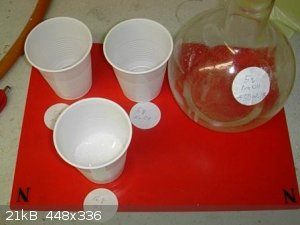 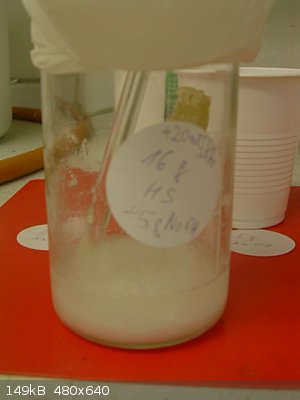 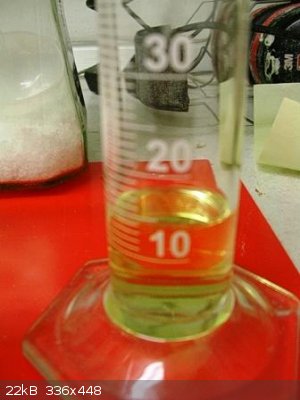 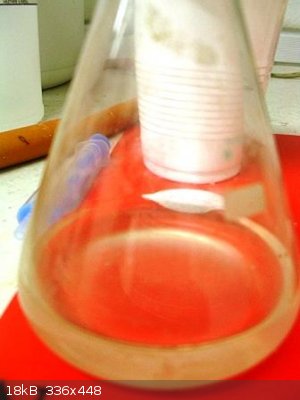 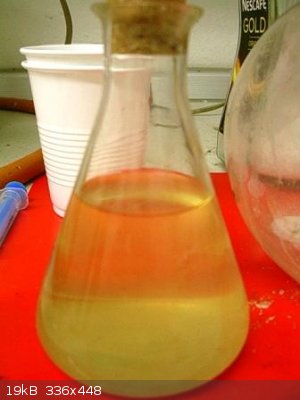 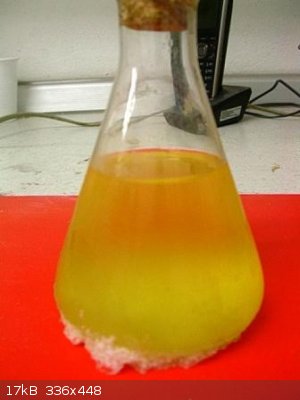 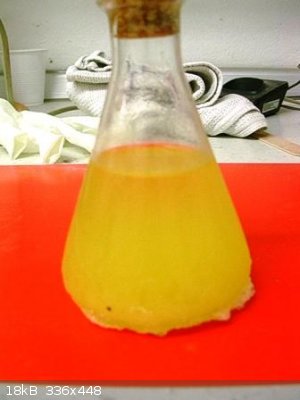 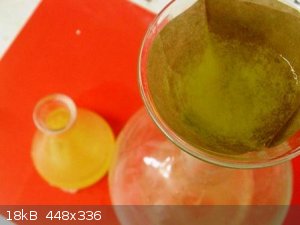 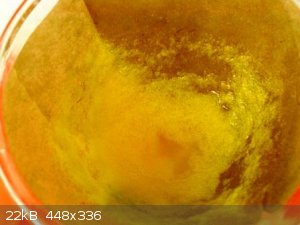 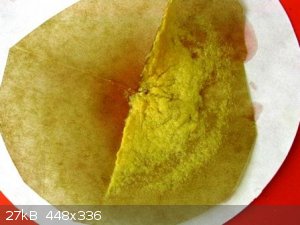 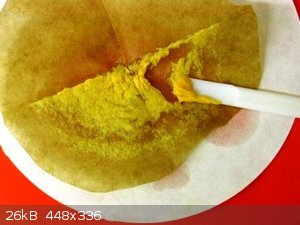 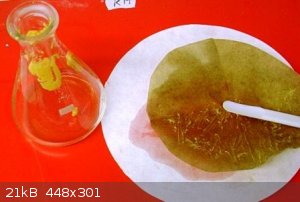 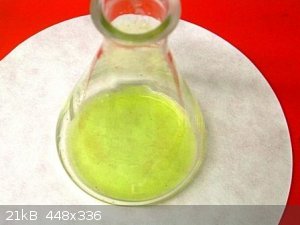 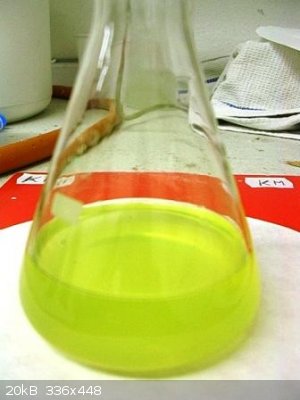 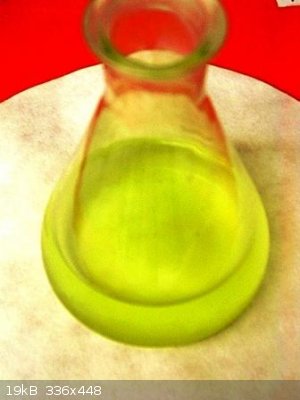
[Edited on 15-10-2016 by Thraxx]
[Edited on 15-10-2016 by Thraxx]
|
|
|
PHILOU Zrealone
International Hazard
    
Posts: 2893
Registered: 20-5-2002
Location: Brussel
Member Is Offline
Mood: Bis-diazo-dinitro-hydroquinonic
|
|
Quote: Originally posted by Theoretic  |
It won't! That's substitution you're talking about; it's not elimination. That's why I specifically said "Hydroxide E2 eliminates nitrite
from IP nitrite". E2 elimination.
OH- won't displace nitrite to form isopropanol; OH- isn't a very good nucleophile and NO2 isn't a very good leaving group, with the C-N
sigma* antibonding orbital at a too-high energy to react with hydroxide.
If hydroxide ever 'displaces' the nitrite, it happens by addition to the N center, then elimination of isopropoxide anion.
[Edited on 16-1-2017 by Theoretic] |
Oh yes I understand now. I simply reused your "eliminates" without noticing the E2.
Yes I was speaking of substitution.
The case of nitrite esters is a hard one because into water they are extremely unstable...while they are very easily made from dilluted HONO (what is
in strong opposition with most other esters that require concentrated acid and water scavenging to schift equilibrium to the right side of the
reaction).
In fact the nitrous ester suffer from very easy retroconversion into the alcohol and nitrous acid...in fact as fast as it was done.
HO-N=O + Alk-OH <===> Alk-O-N=O + HO-H
The reaction is almost instantaneous and may go via several pathways:
-nitrosonium exchange with a proton form water (most probable)
-hydroxyl exchange with a nitrite anion (probably too slow)
-protonation of the alcohol, elimination of water to make carbocation and attack of the nitrite to leave a proton (probably too slow)
So nitrite esters are sensitive to base, to acid like most esters but also to neutral water; leave a nitrite ester for a few seconds into water and it
has already reached decomposition/recomposition equilibrium.
This is the reason organic chemistry likes this reactant so much.
Easily done, easily collected and very reactive (fast reacting).
PH Z (PHILOU Zrealone)
"Physic is all what never works; Chemistry is all what stinks and explodes!"-"Life that deadly disease, sexually transmitted."(W.Allen)
|
|
|
Thraxx
Hazard to Self
 
Posts: 71
Registered: 15-10-2016
Member Is Offline
Mood: No Mood
|
|
Well,but what could be the strange liquid?Hydrazine is reducing. agent.Alcohol is not possible to be reducted,but what the HNO2?Could it be reduced
into HNO azanone ? And is the azanone able to react with hydrazine or alcohol?
---
If the problem is in the lability of alcohol-nitrite,then it should be added either in drops,or it should be diluted.In the old methods they have a
big part of diethylether.May be this is the reason-ether is a solvent for alcohol-nitrite.
From other point of view,in Urbanski,part III.under Baryum azid is described such method,where is ading of ethylnitrite during more hours and is
freezed under -15C.
May be,that the IP extract/IPnitrite method need ether. Or an dropper.
[Edited on 15-10-2016 by Thraxx]
[Edited on 15-10-2016 by Thraxx]
|
|
|
PHILOU Zrealone
International Hazard
    
Posts: 2893
Registered: 20-5-2002
Location: Brussel
Member Is Offline
Mood: Bis-diazo-dinitro-hydroquinonic
|
|
Quote: Originally posted by Thraxx  | Well,but what could be the strange liquid?Hydrazine is reducing. agent.Alcohol is not possible to be reducted,but what the HNO2?Could it be reduced
into HNO azanone ? And is the azanone able to react with hydrazine or alcohol?
---
If the problem is in the lability of alcohol-nitrite,then it should be added either in drops,or it should be diluted.In the old methods they have a
big part of diethylether.May be this is the reason-ether is a solvent for alcohol-nitrite.
From other point of view,in Urbanski,part III.under Baryum azid is described such method,where is ading of ethylnitrite during more hours and is
freezed under -15C.
May be,that the IP extract/IPnitrite method need ether. Or an dropper.
|
No other idea. You have the product in hand so you can do a lot of testing on it...
Smell, evaporation (crystals?), pH, burning, explosion.
You have made so much experiments with a lot of variations on the amount of reactants and procedure. Usually less ingredients is the best to avoid
side reactions --> KISS method (Keep It Short and Simple).
I think the ether may help the nitrite ester to solubilize (especially into the case of less volatile nitrite esters like n-butyl nitrite) and help
the alkaline azide to precipitate from the media.
[Edited on 19-1-2017 by PHILOU Zrealone]
PH Z (PHILOU Zrealone)
"Physic is all what never works; Chemistry is all what stinks and explodes!"-"Life that deadly disease, sexually transmitted."(W.Allen)
|
|
|
Thraxx
Hazard to Self
 
Posts: 71
Registered: 15-10-2016
Member Is Offline
Mood: No Mood
|
|
For the chemistry I am lover and fucker and from this position I feel me not competent,despite of 13 bad experiences, to tell about such important
method like Thiele/Stolle's method is ,that it doesnt work.I will try to look at this method in its historic developement and connections.
|
|
|
Thraxx
Hazard to Self
 
Posts: 71
Registered: 15-10-2016
Member Is Offline
Mood: No Mood
|
|
In the literature is citate the Thiele/Stolle method in relation to industry to the end of WWI.After only like method for labors.Simmilar method in
the industry is citate by Urbanski.
This reaction has 2,59 mol of ethylnitrite and to this ethylnitrite is added during 24 h suspension of 1,8 mol Ba(OH)2 in 2 mol of
10% hydrazin hydrate.All freezed deep under OC.After they bubbled it with CO2 for to remove barium hydroxide.
This reaction should be theoretically 1:1:1 ,but they want to have surplus of etylnitrite and less of hydroxide.
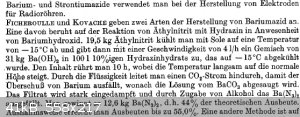 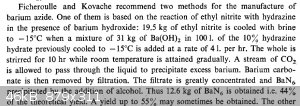 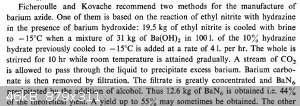
|
|
|
PHILOU Zrealone
International Hazard
    
Posts: 2893
Registered: 20-5-2002
Location: Brussel
Member Is Offline
Mood: Bis-diazo-dinitro-hydroquinonic
|
|
Precipitation of Ba(OH)2 happens as carbonate (BaCO3 is white precipitate).
Because
CO2 + H2O --> H2CO3
H2CO3 <--> H(+) + HCO3(-)
HCO3(-) <--> H(+) +CO3(2-)
and
Ba(OH)2 -aq-> Ba(2+) + 2 OH(-)
OH(-) + H(+) <--> H2O
finally
Ba(2+) + CO3(2-) <--> BaCO3(s)
Don't add to much CO2.
because
H2CO3 + Ba(N3)2 --> BaCO3(s) + 2 HN3
and
HN3 is very toxic (like cyanide) and volatile
PH Z (PHILOU Zrealone)
"Physic is all what never works; Chemistry is all what stinks and explodes!"-"Life that deadly disease, sexually transmitted."(W.Allen)
|
|
|
Thraxx
Hazard to Self
 
Posts: 71
Registered: 15-10-2016
Member Is Offline
Mood: No Mood
|
|
The Barium azide could be advantageously,because it seems be easier to purify.
In this moment I am doing other experiment-I converted the data from BaN6 manufacture to the NaN3:
2,59 mol of ethylnitrite=ekv. 2,59 mol of IPnitrite=265,22ml IPnitrite
1,8 mol of Barium hydroxide=ekv.3,6 mol of NaOH=144g NaOH
2 mol of Hydrazin hydrate=extrakt of 2 mol Hydrazine sulphate=260 g Hydraz.sulfate.
(The citation from Urbanski says nothing about solvent,but if it should be freezed to -15C,then it could be some alcohol.I take technical ethanol)
I gave one half of 1/10 of these amounts= 13ml IPnitrit + 7,2g NaOH(in 50ml tech.ethanol) + extraction of 13 g HS(in 50 ml tech.ethanol). To the
IPnitrite I added yeasterday each one half of hour 5ml of extraction + hydroxide.Hydroxide I gave less than I should gave.And it was funny,I saw the
ethylazid on the bottom there.
Now,after 24 h it is cloudy liquid and I am waiting until it will be clean.
[Edited on 15-10-2016 by Thraxx]
|
|
|
harderm
Harmless

Posts: 9
Registered: 22-10-2010
Member Is Offline
Mood: pistoff
|
|
If we knew the title of the book, we could read it ourselves and answer our own questions. Could you tell us what it is?
|
|
|
Thraxx
Hazard to Self
 
Posts: 71
Registered: 15-10-2016
Member Is Offline
Mood: No Mood
|
|
Chemistry and Technology of Explosives
Vol. III.
by Tadeusz Urbanski
Pergamon press
Warszawa 1965
|
|
|
nitro-genes
International Hazard
    
Posts: 1048
Registered: 5-4-2005
Member Is Offline
|
|
Silver azide directly from hydrazine sulfate
Be very cautious with this reaction, don't scale this up without adaquate protective measures , do this outside or in a fumehood! It is
unknown how much of the extremely toxic and explosive hydrazoic acid escapes the solution as a gas instead of being sequestered by Ag+, especially at
the low pH utilized. Stability of the silver azide produced from this synthesis is also unknown and probably needs thorough washings to get rid of all
traces of sulfuric acid and free hydrazoic, which may increase sensitivity of the end product. Silver azide is one of the most powerful primary
explosives used commercially, with comparatively high sensitivities to friction and static
This was more of a small-scale-proof-of-principle experiment than an optimized synthesis, though the end result was positively identified as silver
azide, others migh like to experiment further with this to maximize yield etc. 
40 ml destilled water was added to a 50 ml erlenmeyer flask, together with 1 ml 98% sulfuric acid. About 100 mg of silver nitrate was added, which
dissolved completely. Excess hydrazine sulfate was added in small increments until nothing dissolved further at room temperature (estimate 0.5 g or
so).
To 10 ml of distilled water was added 0.2 g NaNO2 and dissolved. While at room temperature, the nitrite solution was added very slowly (1 drop every
10 sec or so) to the hydrazine sulfate/sulfuric/silver nitrate solution. Each drop of nitrite produced some fizzling, presumably nitrogen gas from
side reactions of the hydrazine/hydrazoic with nitrous acid. After 10 minutes or so, a dense and pearl white precipitate started to form, which
detonated with extreme vigor from flame in microscopic amounts.
The reaction of hydrazine and nitrous acid is mostly determined by pH and nitrite/hydrazium ion concentration. At low pH and excess hydrazinium,
hydrazoic acid is the main product of the reaction (see attached articles). Apparently, silver azide itself is insoluble enough, even at such low pH,
to precipitate from the reaction and reduce destruction by nitrous acid from solution. Minimizing the amount of sulfuric needed to keep at a pH <1
might work even better, in that the equilibrium between silver azide and free hydrazoic is as far to the silver azide as possible. Hydrazine
nitrate/nitric might also work better due to the relative insolubility of the hydrazine sulfate in the solution, less OTC though.
[EDIT] If I got it right, a 1% solution of sulfuric should have a pH of ~1. With additions of nitrite, a 2% solution of SA seems more than enough to
keep the pH at <1 during the reaction. Just checked the maximum solubility of hydrazine sulfate in a 50 ml solution of 2% sulfuric acid (1 g SA
total), which seems about 0.65 g. (5 mmoles) at 25 C. If the reaction is taken as stoichoimetric, this would correspond to 0.849 g of silver nitrate
and 0.345 g of sodium nitrite to form 0.749 g of silver azide (100% yield). In practice, an excess of hydrazine is probably needed, though 0.5 g of
silver azide from 0.65 g hydrazine sulfate may be possible...the product also seems more dense than formed from NaN3/AgNO3 solutions...not bad! 
Attachment: The kinetics of nitrite scavenging by hydrazine and hydrazoic acids at high acidities.pdf (269kB)
This file has been downloaded 798 times
Attachment: Is hydrazoic acid (HN3) an intermediate in the destruction of hydrazine by excess nitrous acid (659kB)
This file has been downloaded 1065 times
[Edited on 20-5-2018 by nitro-genes]
|
|
|
nitro-genes
International Hazard
    
Posts: 1048
Registered: 5-4-2005
Member Is Offline
|
|
Attachment: Kinetic and product study of the reaction between nitrous acid and hydrazine.pdf (984kB)
This file has been downloaded 780 times
[Edited on 22-5-2018 by nitro-genes]
|
|
|
DubaiAmateurRocketry
National Hazard
   
Posts: 841
Registered: 10-5-2013
Location: LA, CA, USA
Member Is Offline
Mood: In research
|
|
2-Dimethylaminoethylazide
https://en.wikipedia.org/wiki/2-Dimethylaminoethylazide
Has anyone looked into this? Looks like a better UDMH
|
|
|
Etanol
Hazard to Others
  
Posts: 124
Registered: 27-2-2012
Member Is Offline
Mood: No Mood
|
|
Remove sulfuric acid, reduce the temperature to 0С, increase the reaction time to 5-10 hours. And you get a yield of over 90% based on the AgNO3.
AgN3 recrystallized from NH3 is completely safe.
[Edited on 26-1-2020 by Etanol]
|
|
|
Tsjerk
International Hazard
    
Posts: 3022
Registered: 20-4-2005
Location: Netherlands
Member Is Offline
Mood: Mood
|
|
Any references? Or should I take this on your nice blue(?) eyes?
|
|
|
Etanol
Hazard to Others
  
Posts: 124
Registered: 27-2-2012
Member Is Offline
Mood: No Mood
|
|
Conduct an experiment and you will see the white crystalline result  This is not
in the publications. This is not
in the publications.
|
|
|
XeonTheMGPony
International Hazard
    
Posts: 1636
Registered: 5-1-2016
Member Is Offline
Mood: No Mood
|
|
Having difficulties free basing my Hydrazene, When doing it as Chem player does, I end up with a gooey mess then a free flowing sulfate powder that is
easy to separate.
The Alcohol is dried over molecular sieve after thorough purifying.
The Hydrazene is pure and recrystallized.
30grams hydrazene sulfate
50Ml absolute Ethanol
18.6 grams NaOH
So am unsure if I should focus on purity or drying, how much moisture does hydrazene sulfate crystals hold on too?
|
|
|
Hey Buddy
Hazard to Others
  
Posts: 384
Registered: 3-11-2020
Location: Bushwhacker Country
Member Is Offline
|
|
Any recommendation on using this? It's got other components in it. LiOH and KI.
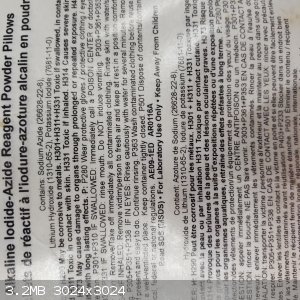 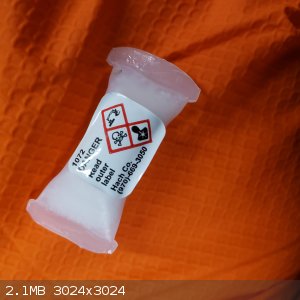
|
|
|
B(a)P
International Hazard
    
Posts: 1110
Registered: 29-9-2019
Member Is Offline
Mood: Festive
|
|
It only has a few percent sodium azide unfortunately.
You could try to make silver azide - This is only a suggestion and I am unsure if it would work, based on your post history I am assuming you know how
dangerous nitrogen dioxide, hydrazoic acid and silver azide are, if not then do some reading first.
On a small scale you could try to make a dilute solution of the alkaline iodide azide then neutralise it with dilute nitric acid.
You will need to be very careful at this point, if it becomes too acidic you could form enough hydrazoic acid that it is liberated from the solution.
If it is too basic your silver nitrate will just be converted into silver hydroxide.
Concentrated nitric acid reacts with potassium iodide to form iodine, but I am unsure if this will occur in a dilute solution, if it does you will
likely get some nitrogen dioxide at this point and you will need to filter out any iodine.
Add a little dextrin and then some silver nitrate to precipitate out silver azide.
Please report back if you try it.
Otherwise they are quite handy for the determination of dissolved oxygen concentrations 
|
|
|
Hey Buddy
Hazard to Others
  
Posts: 384
Registered: 3-11-2020
Location: Bushwhacker Country
Member Is Offline
|
|
I need all of the warnings.
When I was a kid, I ate C4.
I don't know why.
Maybe two or three marble-sized balls
So warnings are always good. Assumptions presume.
I was assuming azides are lethal tier toxicity and thank you
[Edited on 29-1-2021 by Hey Buddy]
|
|
|
B(a)P
International Hazard
    
Posts: 1110
Registered: 29-9-2019
Member Is Offline
Mood: Festive
|
|
Quote: Originally posted by Hey Buddy  | I need all of the warnings.
When I was a kid, I ate C4.
I don't know why.
Maybe two or three marble-sized balls
So warnings are always good. Assumptions presume.
I was assuming azides are lethal tier toxicity and thank you
[Edited on 29-1-2021 by Hey Buddy] |
Really? I thought it was pretty toxic? Didn't soldiers used to go into convulsions because they were using the same knife to cut their food and C4
when using it as a fuel for heading food?
Brings some new meaning to explosive diarrhoea!
|
|
|
Hey Buddy
Hazard to Others
  
Posts: 384
Registered: 3-11-2020
Location: Bushwhacker Country
Member Is Offline
|
|
Just to be concise, nobody should eat C4. It's a poor decision.
|
|
|
MineMan
National Hazard
   
Posts: 996
Registered: 29-3-2015
Member Is Offline
Mood: No Mood
|
|
Russian soldiers put it in their tea... that’s how Putin was caught bombing the apartment buildings...
|
|
|
Hey Buddy
Hazard to Others
  
Posts: 384
Registered: 3-11-2020
Location: Bushwhacker Country
Member Is Offline
|
|
I've been doing sabanejeff-oxidation derived lead azide (dextrin and cmc). I saw this demonstration set up on Astral Chemistry's video channel. This
photo is the first arrangement used. I copied his set up. Sidearm test tube as reaction vessel. HN3 diluted with N2 and NO2 is generated and fed into
a broke off pipette tip through a two hole stopper into lead acetate/cmc/dextrin aqueous solution. The other hole in the stopper has a short section
of pipette connected to a vinyl output hose feeding into a water trap. Hydrazine sulfate and 50% concentration nitric acid are loaded into the
reaction chamber, a gentle heat is applied to the reaction tube, around 30 sec to a min of heating by an electric heat gun initiates the reaction
smoothly. Generating a movement of the reaction mixture and a fizzing followed by bubbling then intense bubbling then tapering off. Mixed HN3 gas is
fed into the receiver chamber loaded with your solution of choice, inorganic hydroxides, acetates and nitrates are the usual solutions.
I have not attempted this with organic substrates. I have been trying this set up using OTC drain cleaner/ AN in situ nitric acid salt mix, instead of
the usual diluted HNO3. It generates HN3 almost as smoothly as using HNO3.
I have had some lessons learned using this set up. Obviously, HN3 is the greatest danger presented by any method using hydrazoic acid, its very
poisonous and explosive when concentrated. This method is advantageous in that its risk of detonation is minimized by small amounts of gas produced at
a time as the reaction proceeds and the gas then neutralized at end point use creating azide directly. The gas is also diluted by the nitric acid
presence which is definitely feeding NO and NO2 and maybe some N2 into the stream.
The gas pressure can become intense depending on the vessel and mass of reactants. Astral recommended 1.5 g N2H6SO4 for 4 cc of 50% HNO3. That ratio
works smoothly. In modifying the procedure to use NO3 salt, I tried at first mixing hydrazine salt with nitrate salt in the reactor and adding H2SO4.
This results in quite an immediate reaction. Ive also blown off the stopper from excess gas pressure from too vigorous of a gas generation, this
should be avoided because it off vents hydrazoic acid into the ambient environmentif you are not using a hood. A better method is to first react the
H2SO4 with nitrate salt for around 15 minutes prior to loading it into the reactor with the hydrazine inside. This method has no immediate reaction
and a reaction doesnt begin until the reactor is heated to around ~100 C.
I have also had issues with bubbling of reaction mixture through the side arm into the receiver. This makes a mess. The solutions I found helpful were
using a larger 125 ml flask as the reaction vessel with a longer section of hose fed into the receiver. The hose is connected to a section of 90
degree glass pipe through a one hole stopper. The stopper to the flask is much larger than the test tube stopper and squeezes in tightly with a
greater surface area. It has not fired off into the air like the original set up. As of now reaction batch sizes are increased to around 5 ml H2SO4/AN
with 5 ml H2O and 3 g hydrazine sulfate.
Hoses degrade from the gasses and so they are consumables in this method but very short lengths are used. I should also mention that I leave the area
after the reaction begins and allow it to proceed for 30 min before returning. If I have to stay in the area next to the reactor, I put a stack of
bricks in front of the glass for the unlikely hazard of detonation. For clean up I use paper towels and a waste beaker and put all of the contents
into a hot fire out doors after cleaning. Im still working on optimizing this method but I thought it was pretty basic and simple. The process that is
occurring isnt well understood but its believed to maybe be a breakdown of N2H4 HNO3 into HNO2 that then forms HN3. Using a mixed nitrate salt drain
opener reaction mix along with simple hydrazine sulfate makes this method of azide very simple compared to other methods. Azide can be prepared
quickly because the reaction is only around 15 minutes and the preparation is very minimum as there is no staging. No requirement of organic nitrite
preparation and hydrazine sulfate can be used direct without free basing. Very fast once set up. You can easily make 1-3 g at a time for detonators.
edit:
I would like to know how other people clean up their equipment after making azides. I would imagine that there are some tips I could pick up because
other than making a nitrite bath and dumping everything in, I'm not sure what the best way to clean up is other than rinsing everything with water and
using paper towels then incinerating everything,.
edit: I hadnt considered hypochlorite but this seems to work way better than HONO. It renders the N3 into N2 and Cl and is much cheaper than HONO and
less hazardous. Im going to start using a CaHOCl bath in a bucket as the disposal medium.
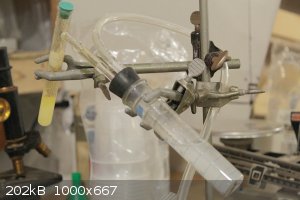
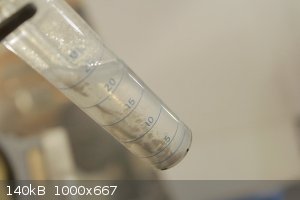
[Edited on 7-1-2023 by Hey Buddy]
[Edited on 7-1-2023 by Hey Buddy]
|
|
|
dave321
Harmless

Posts: 45
Registered: 22-11-2012
Member Is Offline
Mood: No Mood
|
|
Quote: Originally posted by Etanol  |
Remove sulfuric acid, reduce the temperature to 0С, increase the reaction time to 5-10 hours. And you get a yield of over 90% based on the AgNO3.
AgN3 recrystallized from NH3 is completely safe.
[Edited on 26-1-2020 by Etanol] |
i thought crystalline silver azide was more sensitive than amorphous azide.
can yo qualify your statement "AgN3 recrystallized from NH3 is completely safe." with more details ?
i was thinking of the costain process
[Edited on 7-1-2023 by dave321]
|
|
|
| Pages:
1
..
14
15
16
17
18 |